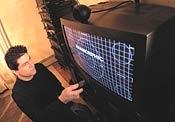TV Tweaks - Part One: House Calls

You finally made the plunge - you bought a new TV. After countless hours of research and comparing Model A to Model B, you're ready to get down to business. So you pop in a demo DVD, fire up the audio system, adjust the lighting, sit back in your favorite chair, and press play. But something isn't right. Everyone looks a little sunburned. And the "deep blacks" you read about in the magazine review of your TV don't look all that deep or black.
The owner's manual says you should "adjust the color and tint controls to achieve accurate flesh tones." So you start punching buttons, trying to make the picture better but not getting anything that looks like any skin you've ever seen.
You go back to the original review to see if it said anything about having to adjust the set. And there, in a small box labeled "in the lab," you read, "Calibration needs to be performed by a qualified technician with specialized equipment, so discuss it with your dealer before purchase, or contact the Imaging Science Foundation." Well, it might be too late to discuss it with your dealer, but it's never too late to consult a professional. Even an old set will perform better when it's properly adjusted.
The Psychology of Selling I'm sure the idea that you can't just take a TV out of the box, plug it in, and get a good picture isn't sitting real well with you, especially after you just paid a grand or more for a new set. And you'd like to think you can do all the adjustments yourself - until you remember your dad's well-intended efforts to adjust the family TV, which made everybody look like Klingons. Well, there's probably nothing wrong with your set. It's almost certainly producing the picture the manufacturer set it to produce. But those settings aren't accurate.
TVs are adjusted at the factory to produce images that will make them stand out from the competition on harshly lit sales floors. It takes an awfully bright picture to overcome all that light. So when you place a brand-new TV in a properly dimmed environment like a home theater, the factory-set picture is going to be off - way off.
To make them as bright as possible, most TVs come out of the box with the contrast (or "picture") control at its highest setting. Jacking up the contrast to maximum is like always driving your car revved near the red line. You can do it, but it's going to cut down on your engine's lifespan, and excessive contrast will reduce a picture tube's lifespan. It also distorts the picture geometry and causes "blooming," which reduces resolution.
Most TVs are also preset for a high color temperature, which makes the picture look blue. Unless you're James Cameron shooting the finale of Titanic, you probably don't want that. To compensate, manufacturers sometimes design the set's color decoder with a red push, but that leads to the reds being overemphasized. This is most noticeable on faces.




























































